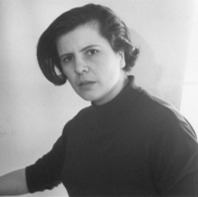
Charlotte Posenenske
Charlotte Posenenske was a prominent German artist closely associated with the minimalist movement. She was born in 1930 into a Jewish family in Wiesbaden, Germany, and spent her childhood in hiding during Nazi rule. After the war's end, Posenenske studied under the guidance of Willi Baumeister, who introduced her to Modernism.
Charlotte Posenenske's Art Style
Posenenske had a keen fascination with painters who explored the spatial qualities of a pictorial surface, finding inspiration in the works of Cézanne and early Mondrian. She traveled to the places they had lived and made plein-air paintings. Her earliest surviving artworks date back to the late 1950s, showcasing her exploration of contemporary art movements like Informel and Abstract Expressionism. Notably, she differed from many of her male colleagues in her approach to individual expression, preferring to create a sense of distance between herself and the painting's surface by using a palette knife to apply paint to the canvas.
Throughout the 1960s, Posenenske increasingly simplified her use of color and shapes, representing landscapes with mere horizontal lines denoting the sky and earth. Her interest in Constructivism grew, leading her to create a series of black ink circles resembling musical notes. During this period, she also delved into the realm of sculpture. The exhibition curated by Konstantin Adamopoulos and Burkhard Brun shed light on her artistic evolution. Posenenske began by applying primary colored sticky strips to paper, creasing and layering them until shapes were built up, as exemplified in her work "CMP 65" from 1965.
She then used sheet metal sprayed with monochrome paint, shaping them into sculptures, sometimes combined with corrugated cardboard to produce the "Vierkantrohre" (Square Tubes, 1967) series that resembled ventilation shafts. These sculptures were conceived as modular pieces adaptable to different spaces.
She embraced reductive geometry, repetition, and industrial fabrication, leading her to develop a form of mass-produced sculptural Minimalism. Through this approach, she addressed the pressing socioeconomic concerns of the decade by circumventing the art market and rejecting established formal and cultural hierarchies. Posenenske used playful conceptual devices to oppose compositional hierarchy and encouraged the collaborative engagement of the public in the continual reconfiguration of her variable sculptures.
Until 1968, she actively exhibited her work alongside famous artists such as Hanne Darboven, Donald Judd, and Sol LeWitt.
In 1968, Posenenske decided to cease her artistic career, no longer believing that art could effectively influence social interactions or draw attention to social inequalities. The artist shifted her focus to sociology, which became her area of study until her passing in 1985. During this time, she chose not to visit any exhibitions or display her work.
Charlotte Posenenske died in 1985 in Frankfurt am Main, Germany.
Years:
Born in 1930
Country:
Germany, Wiesbaden